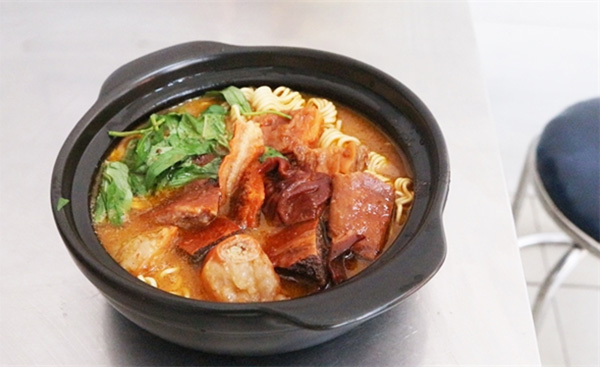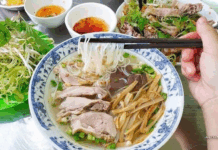 |
| Offal stew can also be eaten with noodles, and offal parts can even be served deep fried. — VNS Photo Viet Dung |
Offal stew is a dish of Chinese origin and is said to have been made as a way to fully use all parts of the animal.
Beef offal parts such as lungs, intestines and livers are first washed carefully with salted water, then boiled with some ginger to get rid of the offal’s strong smell.
The offal stew itself is cooked with garlic, five spices, and other seasonings, with its most important ingredient being coconut milk and annatto powder, a red food colouring that gives the dish its signature red and orange colour. Certain restaurants may use cow milk instead to enrich the soup.
Offal stew restaurants around HCM City prepare a huge pot of stew with large offal parts inside. When customer orders are received, the parts are cut into smaller, bite-size pieces, then added to a bowl of stew and served with either instant noodles or bread.
Dipping sauce made with kumquat sauce and chilli is also served to give the dish a sour and spicy taste.
While most customers order a mixture of different parts, they can also ask for specific offal parts depending on their preference.
The soup, made creamy due to the coconut milk, is the most outstanding characteristic of the stew, and is the reason why the dish is so popular in HCM City, especially among children who often like to drink the soup.
Offal parts may not be everyone’s cup of tea, but their soft and slightly spongy texture (aside from liver) means that the rich creamy soup is partially absorbed into the parts, improving their taste.
Offal parts can also be served deep-fried or stir-fried with noodles, while still retaining their creamy taste.
Specialty of District 4
Nguyen Thi Bach Lien’s offal stew restaurant has been open for nearly 20 years, in a small neighbourhood in District 4 where many other offal stew restaurants sell their dishes.
“This neighbourhood has been making a living with offal products for decades,” Lien said, adding that while Chinese-Vietnamese tend to use pork offal for their stew, Vietnamese typically use beef offal instead.
“This neighbourhood here pretty much only uses beef offal. Offal stew is a specialty of District 4.”
Lien and her family often wake up at 6am to begin preparing the stew; cleaning the ingredients takes around two hours, and cooking them takes another two.
She noted that they have to use the right amount of seasoning when cooking the stew to get rid of the smell: not too little, but not too much.
Bui Vien Viet, an elderly man who eats offal stew at Lien’s restaurant nearly every day, said the stew is very creamy and has a nice taste and smell.
A short walking distance from Lien’s place is another offal stew restaurant where cooks are often seen packing large bags of offal pieces and soup separately for customers ordering takeaways.
Van Hoa Anh Tho, who works for her family restaurant, said that it has been open for around 10 years. Her grandmother cooks the stew inside, while the rest of her family serves customers at the front of their restaurant.
“The stew can be enjoyed by all groups: students, labourers, office workers and others. We also have a lot of customers from other districts,” Tho said.
Pham Thi Ngoc Quyen, a customer from Ba Ria – Vung Tau Province, said that she had never tried the dish before in her local region, and liked the stew due to its unique, creamy flavour and soft offal pieces.
“Every time I visit HCM City I always have some offal stew.” VNS
Viet Dung



